There have been times in recent years when an ammunition shortage almost shut down our handgun training business. We bought a Lee Breech Lock reloading press and used it to keep our classes supplied with ammunition. There were months when we were the only instructors conducting classes in our area because we were the only ones with ammunition.
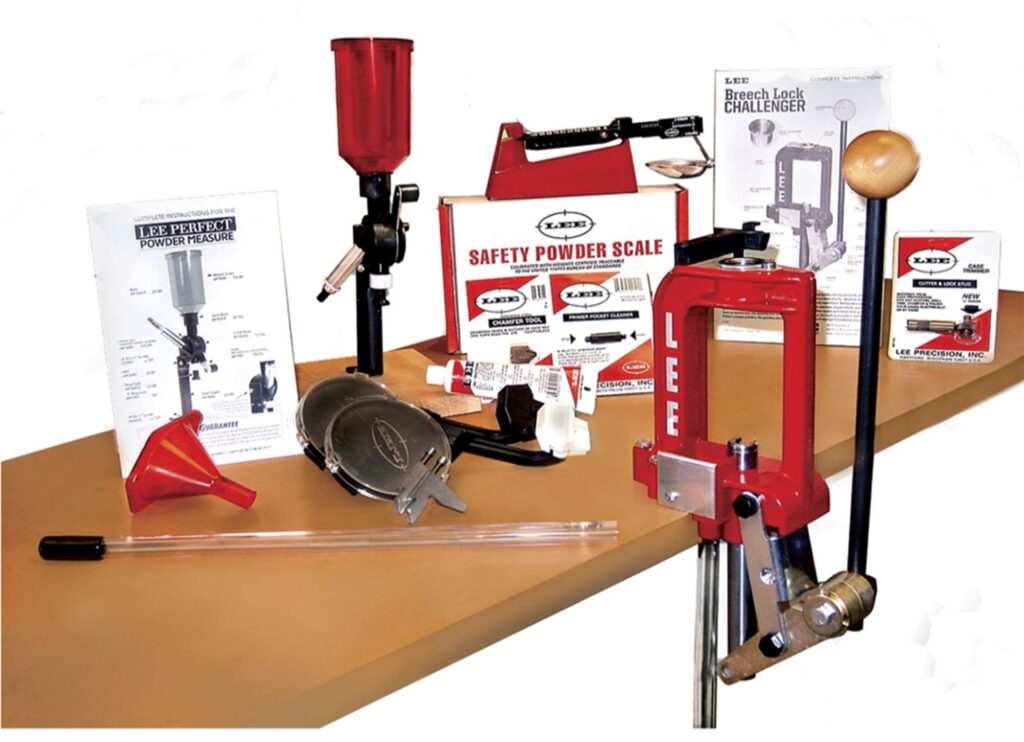
The Lee Precision Breech Lock Challenger Press Kit
You’ll see the terms handloading and reloading. They are basically the same but with different goals. Clean some empty cartridge cases, remove the old primers, insert new ones, resize the cases, pour in some gun powder, insert a bullet in each case, press it down a measured amount and crimp it. You now have cartridges ready to shoot. Handloaders experiment with different powder and bullet combinations to optimize performance for a particular purpose such as hunting, long range target practice or defense. Reloaders are basically seeking value, reusing spent brass to make ready-to-fire rounds. I’m going to show you how easy it is to begin reloading.
Although each step in the process I just described can be done with hand tools, it’s much cooler to use a press. The Lee Precision Breech Lock Challenger Press Kit has all the accessories you’ll need to get started. You’ll need a reloading die kit for each caliber you want to reload, plus primers, gunpowder and bullets.
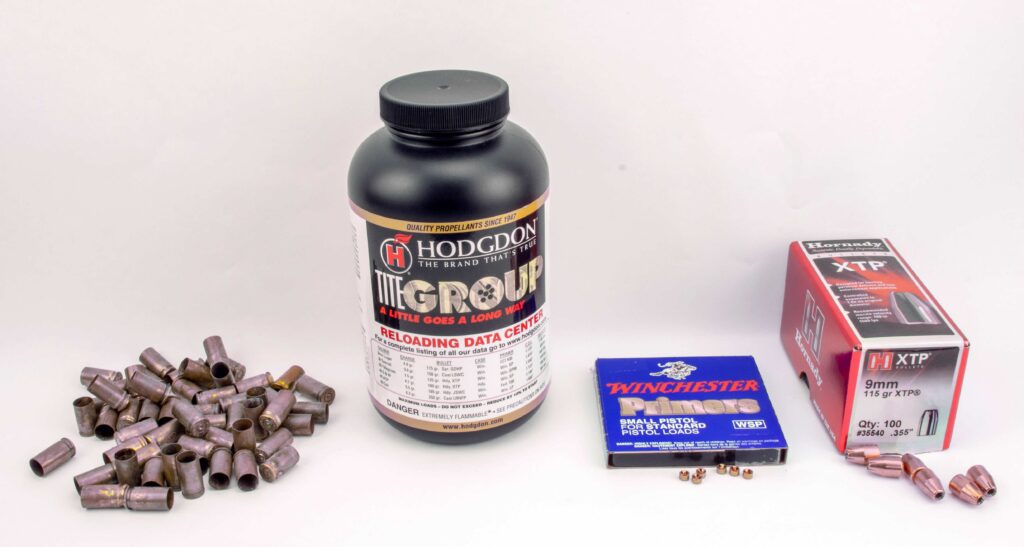
Following published loading specifications is imperative. Failure to do so can result in serious injury, even death. I use a combination of data sources: Lyman’s Pistol & Revolver Handbook – Third Edition is my primary source, but I also refer to the labels on the gunpowder I’m using, and the charts included in the Reloading Dies used for each caliber. The published values will be listed by bullet weight and type with a starting load and a maximum load. Never exceed the maximum load. I usually pick a charge that’s close to halfway between the minimum and maximum published values for the type of powder and the bullet type and weight I’m using.

Lyman’s Pistol & Revolver Handbook
To reload you now need some shell casings, gunpowder and projectiles. Most people start with shell casings gathered from their range trips. It would be rare to find a range that had a problem with you collecting your own shell casings but check the range’s policy before you start sweeping up brass left behind by other shooters. Some ranges won’t care, but many sell their brass as an additional source of income. In a pinch you can buy new brass. Technically, that’s not reloading but I won’t tell if you won’t. Before reusing brass inspect it carefully for cracks or separation, then clean it. I’ve used two methods. The Lyman Pro 1200 Turbo Tumbler uses crushed corncob or walnut shells to scrub the brass clean while it tumbles along. You can put two or three hundred pistol-size cases in the tumbler at a time and let them tumble until they get clean. Times vary, but it’s not a quick process.
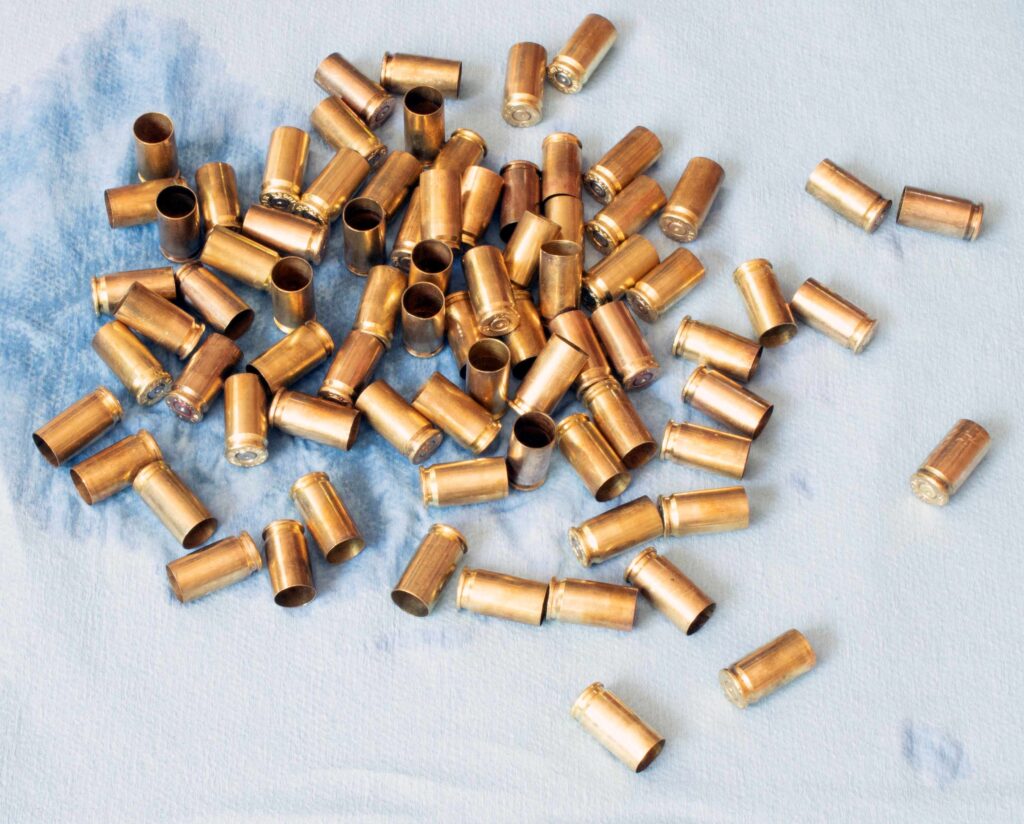
Brass Picked up from Range
If you’re in a hurry you can clean your brass chemically. Iosso Case Cleaner cleans brass casings chemically in just a couple of minutes. Put as many as 20 or 30 brass casings in a small net bag and dunk it in the chemical for up to 5 minutes, then rinse them with water. Dry them off with paper towels and you’re ready to go. At times I use the tumbler, but when I’m in a hurry the Iosso does the job.
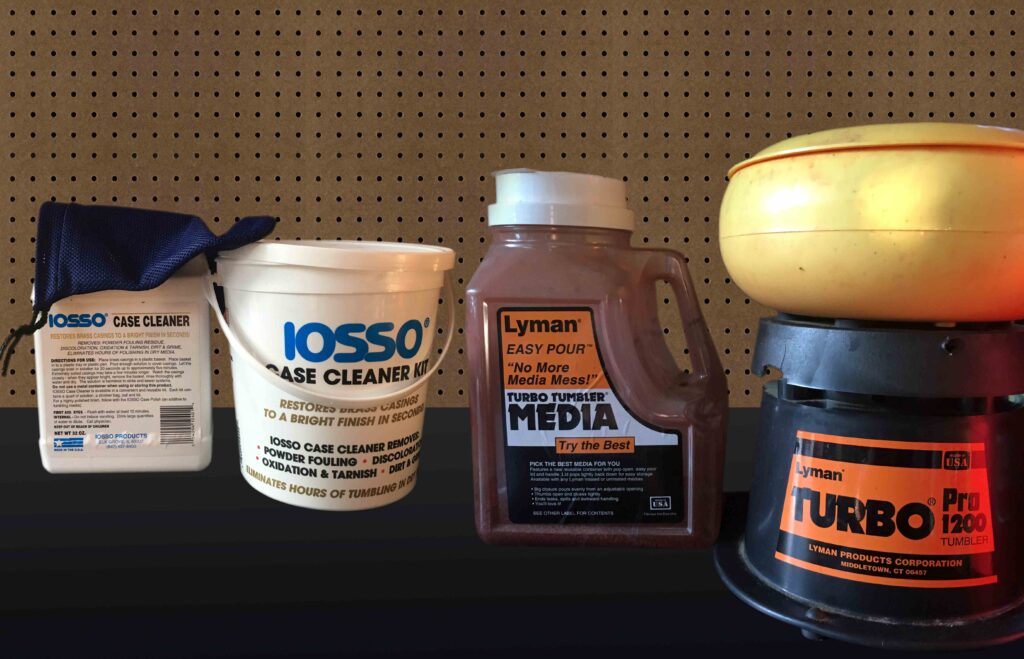
How do you decide what type of gunpowder to buy? Look through your Lyman Pistol & Revolver Handbook or other reloading charts to see what powders are common to the calibers you’ll be reloading. Looking at the charts for 9mm, .40 S&W and .45 ACP in the weights and bullet types I normally use I bought some Hodgdon TiteGroup. The Lyman chart for the 9mm XTP bullets lists TiteGroup as the powder most likely to produce the best performance. The charts also tell me what size primers I need. Small Pistol Primers from CCI or Winchester are used for 9mm cartridges.
When it comes to bullets, I load a lot of FMJ for target practice, but I’m currently loading some Hornady FTX JHP and some Inceptor ARX, both designed for defensive use. All the experts recommend we don’t carry reloaded ammo in our personal protection guns, but reloading something for practice that shoots just like the factory ammo I do carry, but cost less, makes sense to me.

When I’m ready to load some ammo I start by installing the Sizing and Decapping die on the press. I put a small pistol primer in the cup of the primer arm that’s mounted on the press. I pull the press’s lever down and the case is re-sized and de-primed. As I push it back up, the new primer is seated into the case. I do that for each of the shells in our reloading tray.
The Breech Lock feature of the Lee Press uses a threaded integral lock collar that provides a quick-change bushing for changing dies with just a twist of the wrist. It’s easy to replace the Sizing and Decapping die with the Expander and Powder Funnel die. The chart I’m using from the Lyman Pistol & Revolver Handbook lists the TiteGroup starting load for a 115 grain JHP bullet as 4.0 grains and the Max Load 4.5 grains. The chart that came with the dies lists a 4.0 to 4.8 range. I pick 4.3 grains. Thanks to a small digital scale and the powder dipper that came with the dies, I can measure the load for each bullet accurately. Now it’s time to pull the lever on the press. Doing so slightly expands the case mouth to accept the bullet. With the lever all the way down I put a small funnel in the mouth of the die and pour in the powder. When using a plastic funnel, static electricity is sometimes an issue. To avoid having powder stick to the funnel you can wipe it with a dryer sheet just before using. I do this for each case, again placing them upright in our reloading tray. That is a hand way to check all the cases to make sure the powder loads look even before loading projectiles.
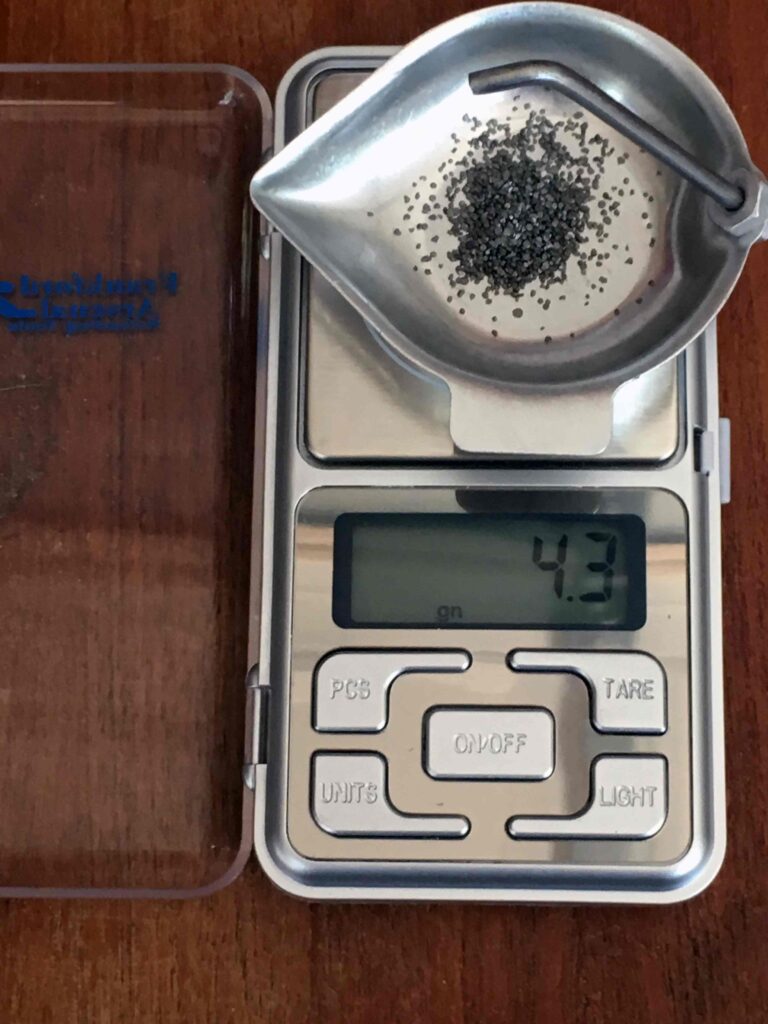
Time to change the die again to the Bullet Seating die. This die requires some adjustment to get the bullet seating depth correct. This is as important as getting the right powder charge because a bullet pushed in too far will increase pressure in the cartridge, perhaps beyond specs. I knew my die was pretty close from a previous loading session, but just to make sure I used a digital caliper to check the OAL of the first one loaded. The Lyman chart listed the OAL as 1.0100″. My first one was just a hair too long. A tiny clockwise twist of the sizing knob and I was in business. For each case I carefully inserted a bullet into the top of the expanded case, then pull the lever to seat it to the proper depth. Lifting the lever up this time results in a 9mm cartridge ready to go.
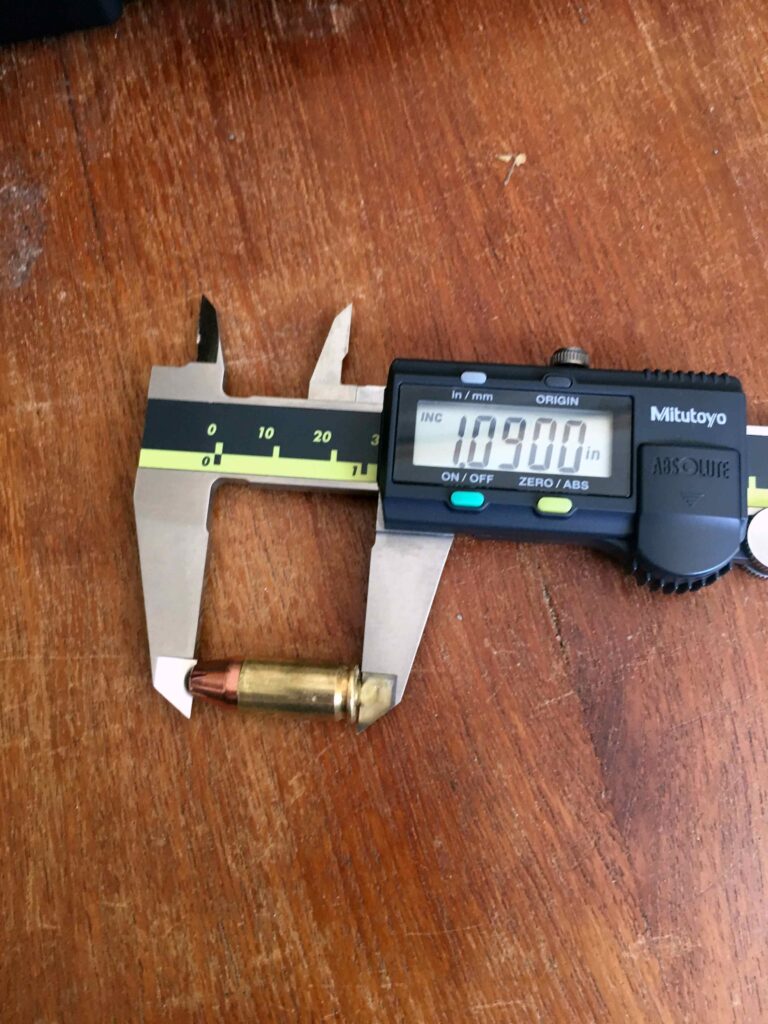
Most of us don’t load one cartridge at a time. We do them in batches. A caliber size Hornady reloading tray helps keep everything organized. Run a bunch of cases through the resize, re-prime routing and put them in the tray. When you’ve done all the brass you want, switch out the die and run each case through the flare and powder step. This will give you a good chance to QC your cartridges when they’re back in the tray to make sure all the powder loads are even. Leaving one empty while doubling the load on another could produce catastrophic results.
When you run the last step, you can feel some pride in adding the new cartridges to your arsenal. Not only did it cost less, but you have a personal investment in making your target shooting rewarding.








